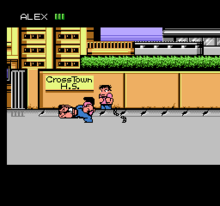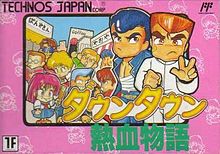- River City Ransom
-
River City Ransom 
North American box artDeveloper(s) Technōs Japan (NES)
SPS (X68000)
KID (Super CD-ROM²)
Million (GBA)Publisher(s) Director(s) Mitsuhiro Yoshida, Hiroyuki Sekimoto Composer(s) Kazuo Sawa Platform(s) Nintendo Entertainment System, Sharp X68000, PC-Engine Super CD-ROM², Game Boy Advance, Virtual Console Release date(s) Genre(s) Beat 'em up,
Action role-playingMode(s) Single-player, multiplayer Rating(s) - ESRB: E10+ (Virtual Console version)
Media/distribution 2-megabit ROM cartridge (NES), 32-megabit ROM cartridge (GBA), CD-ROM, download River City Ransom, released as Downtown Nekketsu Monogatari (ダウンタウン熱血物語 Dauntaun Nekketsu Monogatari, lit. "Downtown Hot-Blooded Story") in Japan and as Street Gangs in PAL regions, is a video game for the Nintendo Entertainment System (NES). It was developed by Technōs Japan and originally released in Japan on April 25, 1989. It is the third game in Technos' Kunio-kun series released for the console, preceded by Renegade and Super Dodge Ball. Like its predecessors, River City Ransom underwent great changes in its storyline and graphical presentation during its localization in order to make the game more palatable in the western market. It was one of the first console games published by North American subsidiary American Technos.
Remakes of the game have been released for the Sharp X68000, PC-Engine Super CD-ROM², and Game Boy Advance (GBA). The NES version was re-released on the Wii's Virtual Console in 2007.
Contents
Gameplay
The plot follows high school students Alex and Ryan as they cross River City in an attempt to rescue River City High and Ryan's girlfriend Cyndi from the clutches of a villain called "Slick".[10] Along the way, they battle with gangs of students (with names such as "The Generic Dudes", "The Frat Guys", "The Jocks" or "The Squids") and several gang leaders which act as bosses or sub-bosses.
River City Ransom is a beat 'em up game with several role-playing elements. The game is fairly non-linear,[11] allowing players to explore an open world.[12] The fighting style is very similar to Double Dragon, in that the player can move freely around the screen while pressing buttons to punch, kick, or jump. Objects such as brass knuckles, steel pipes, and trashcans can be used as melee weapons or thrown at enemies.[10] However, the characters' effectiveness in battle is determined by several statistics and their knowledge of fighting techniques, such as Grand Slam, Stone Hands, and Dragon Feet, which are purchased as books in shops throughout the city using funds recovered from defeated gang members.[10] This loot may also be spent on various food items and spa treatments which serve to not only revitalize the player's stats, but may also permanently increase attributes like "Punch" and "Kick" (Foods and items offer varying levels of improvement).
The player can input passwords that keep track of their character's stats, skills, possessions, money, and defeated bosses.[10] There are a total of nine gangs in the original NES version (which are distinguished by the color of their t-shirts) whom the player will encounter during the course of the game, each with their own characteristics and attacking patterns.
Development
River City Ransom is an English localization of the Family Computer video game Downtown Nekketsu Monogatari, which is the third title starring Technōs Japan's mascot character Kunio, who previously appeared in Nekketsu Kōha Kunio-kun and Nekketsu Kōkō Dodgeball Bu (the Japanese versions of Renegade and Super Dodge Ball respectively). This is the first game in the series where Kunio teams up with his rival Riki, who fought against Kunio in the previous games. The gangs the players fight in the Famicom version are all students from different high schools and many of the characters introduced in this game would reappear in subsequent Kunio-kun games (particularly those that were directed by Sekimoto and Yoshida).
In addition to anglicizing all of the characters' and locations' names, as well as the game's dialog in the English translation, the characters' sprites were also redrawn, replacing their Japanese school uniforms with t-shirts and jeans. The number of difficulty settings was reduced from three to two (the easiest difficulty setting was removed and the Medium setting in the Famicom version became the Novice setting in the NES version) and an alternate 2-player mode (2P Play B) which disables player-against-player damage was removed too. In addition to a Password feature, the Japanese version also features support for the Turbo File, a peripheral released only in Japan that allows the player to save and load game data.
River City Ransom was the first console game localized by Technōs Japan's U.S. subsidiary, American Technos Inc. Although most of Technōs Japan's previous games (such as Renegade and Double Dragon) were released in North America as well, they were licensed out to other publishers. The second and final NES game released by American Technos was Crash 'n the Boys: Street Challenge, which was also a Kunio-kun game.
Ports
X68000
Downtown Nekketsu Monogatari was ported to the Sharp X68000, a Japanese computer platform, and released in April 1990. This version of the game, which was developed by SPS and published by Sharp,[4] features several enhancements to the Famicom original, such as displaying three enemy characters on-screen instead of just two, slightly more colorful graphics, an expanded game world, and new items and special techniques for the player (including some that were only used by certain enemy characters in the Famicom version, such as the headbutt and the whirlwind kick). The new locations includes several new shops (such as a dojo) and the schools of each enemy gang, each featuring two new bosses. In addition to the player's regular stats, the player also has individual stats for all the special techniques their character has acquired. The more frequently a special move is used to finish off enemies, the stronger that particular move becomes. Unlike the Famicom version, the X68000 does not feature adjustable difficulty settings. The player can save and load their progress in one of ten save files provided by the game itself.
PC Engine
The PC Engine Super CD-ROM² version of Downtown Nekketsu Monogatari, released on December 24, 1993, was published by Naxat Soft and developed by KID, the same team that did the PC Engine versions of Nekketsu Kōkō Dodgeball (Super Dodge Ball), Double Dragon II: The Revenge, and Downtown Nekketsu Kōshinkyoku.[13] This version features enhanced graphics, an arranged redbook soundtrack and fully voiced characters, with the voices of Kunio and Riki performed by Ryō Horikawa and Nobutoshi Canna respectively. The player's progress is saved in this version on the PC Engine's backup memory. The rest of the game is almost identical to the Famicom version.
Game Boy Advance
A GBA version of the game, titled River City Ransom EX (ダウンタウン熱血物語ex Downtown Nekketsu Monogatari ex) was released in Japan on March 5, 2004 and in North America on May 26, 2004.[5][6] This remake was developed by Million and published by Atlus. The most notable change from the original version is the loss of a true cooperative mode. Instead, the game can be played with an AI-controlled partner, and players may exchange the data of their own characters to fight alongside each other. The GBA version also includes a vast amount of configurable options that can adjust game play on the fly, such as changing AI behaviour, the amount of enemies in one map area, and shop item reshuffling frequency. The password system is replaced by battery backup, which allows saving up to 12 characters. Character's appearances, keystrokes for learned techniques, even enemy characters can be customized and saved using secret shop items. A saved game does not store story progress or reputation, but it does store the player's statistics, techniques, current items and money, player's name, and customized appearances. The player can gain additional computer-controlled allies and form a "posse" who helps the player on his adventure. Some of these are boss characters from the original NES version, while others are taken from later Downtown Nekketsu games. The player can be accompanied by up to three AI-controlled partners.
Wii
The original NES version of River City Ransom was re-released on the Wii's Virtual Console service in Japan on October 23, 2007, in PAL regions on February 21, 2008, and in North America on April 21, 2008.[7][8][9] The western NES titles, graphics, and storylines for the latter two releases were left intact.
Reception and legacy
The Japanese version, Downtown Nekketsu Monogatari, was considered highly successful and would be followed by several spinoffs (including seven subsequent Famicom installments) until Technos Japan's closure in 1996. Of these seven games, Downtown Special: Kunio-kun no Jidaigeki dayo Zen'in Shugo features the same gameplay system as Monogatari, with the main difference being that the characters are re-enacting a jidaigeki play.
Outside Japan, River City Ransom was not highly successful when initially released. However, due to its unique gameplay and sense of humor, it is today considered a cult classic. This cult following, combined with the game's character and humor, inspired parallel works.
In 2002, an aspiring game designer, tester for Atari, and longtime fan of the game obtained the title's trademark and began work on a sequel aptly titled River City Ransom 2. The project was halted when it was announced at the Electronic Entertainment Expo in 2003 that River City Ransom EX was to be released the following year.[14] However, a true sequel to the game was announced on March 18, 2011. Downtown Nekketsu Monogatari 2 (ダウンタウン熱血物語2) is being developed by Miracle Kidz for a Japanese release on WiiWare in 2011. An online PC version is due out in 2012.[15]
The graphic novel series by Bryan Lee O'Malley, Scott Pilgrim, has references to River City Ransom, including fallen rivals exploding into coins. The XBLA/PSN game Scott Pilgrim vs. the World: The Game is heavily influenced by River City Ransom. Taking from it it's unique super deformed style, enemies exploding into coins when defeated, and shops that have power-ups.
References
- ^ "VC ダウンタウン熱血物語" (in Japanese). Nintendo. http://www.nintendo.co.jp/wii/vc/vc_dtn/vc_dtn_01.html. Retrieved 2011-05-06.
- ^ "NES Games" (PDF). Nintendo. http://www.nintendo.com/consumer/gameslist/manuals/nes_games.pdf. Retrieved 2011-04-02.
- ^ Eggebrecht, Julian (August 1993). "Street Gangs" (in German). Total! (Future Publishing): p. 69.
- ^ a b "株式会社 エス・ピー・エス~博物館―Window" (in Japanese). SPS. Archived from the original on August 7, 2007. http://replay.waybackmachine.org/20070807140628/http://www.sps.co.jp/05_03_other02.htm. Retrieved 2011-04-02.
- ^ a b IGN Staff (March 8, 2004). "Now Playing in Japan". IGN. http://gameboy.ign.com/articles/497/497224p1.html. Retrieved 2011-04-02.
- ^ a b Castro, Juan (May 26, 2004). "River City Ransom EX Ships". IGN. http://gameboy.ign.com/articles/519/519189p1.html. Retrieved 2011-04-02.
- ^ a b Fletcher, JC (October 23, 2007). "VC Tuesday: Best week ever". Joystiq. http://www.joystiq.com/2007/10/23/vc-tuesday-best-week-ever/. Retrieved 2011-04-02.
- ^ a b Calvert, Darren (February 21, 2008). "EU VC Releases - 22nd February - Street Gangs". Nintendo Life. http://vc.nintendolife.com/news/2008/02/eu_vc_releases_22nd_february_street_gangs. Retrieved 2011-04-02.
- ^ a b c d Thomas, Lucas M. (April 21, 2008). "River City Ransom Review". IGN. http://wii.ign.com/articles/868/868095p1.html. Retrieved 2011-04-02.
- ^ Kramer, Josh (29 July 2004). "River City Ransom". Thunderbolt. http://www.thunderboltgames.com/reviews/article/river-city-ransom-review-for-nes.html. Retrieved 16 October 2011.
- ^ Plante, Chris (June 22, 2010). "Every Easter Egg Hidden in the Scott Pilgrim Video Game Trailer". UGO Networks. http://www.ugo.com/games/river-city-ransom. Retrieved 16 October 2011.
- ^ "KIDゲーリスト(PCエンジン)" (in Japanese). http://www5b.biglobe.ne.jp/~mx-5/kid/kidlistpce.htm.
- ^ Frank Cifaldi (2004). "Realize Games' River City Ransom 2". Lost Levels Online. http://www.lostlevels.org/200402/200402-rcr.shtml. Retrieved June 21, 2006.
- ^ Anoop Gantayat. "River City Ransom Sequel Set for WiiWare". IGN. http://wii.ign.com/articles/115/1157652p1.html. Retrieved March 25, 2011.
External links
- Official River City Ransom EX webpage
- Official Downtown Nekketsu Monogatari ex webpage (Japanese)
- River City Ransom at MobyGames
Kunio-kun video games Fighting Sports Super Dodge Ball · Super Dodge Ball (NES) · Super Dodge Ball (Neo Geo) · Super Dodgeball Brawlers · Nintendo World Cup · Crash 'n the Boys: Street Challenge · Nekketsu! Street Basket: Ganbare Dunk Heroes · River City Soccer HooligansRelated games Categories:- 1989 video games
- Atlus games
- Beat 'em ups
- Cooperative video games
- Game Boy Advance games
- Organized crime video games
- Kunio-kun games
- Nintendo Entertainment System games
- High school-themed video games
- Sharp X68000 games
- TurboGrafx-CD games
- Virtual Console games
Wikimedia Foundation. 2010.



